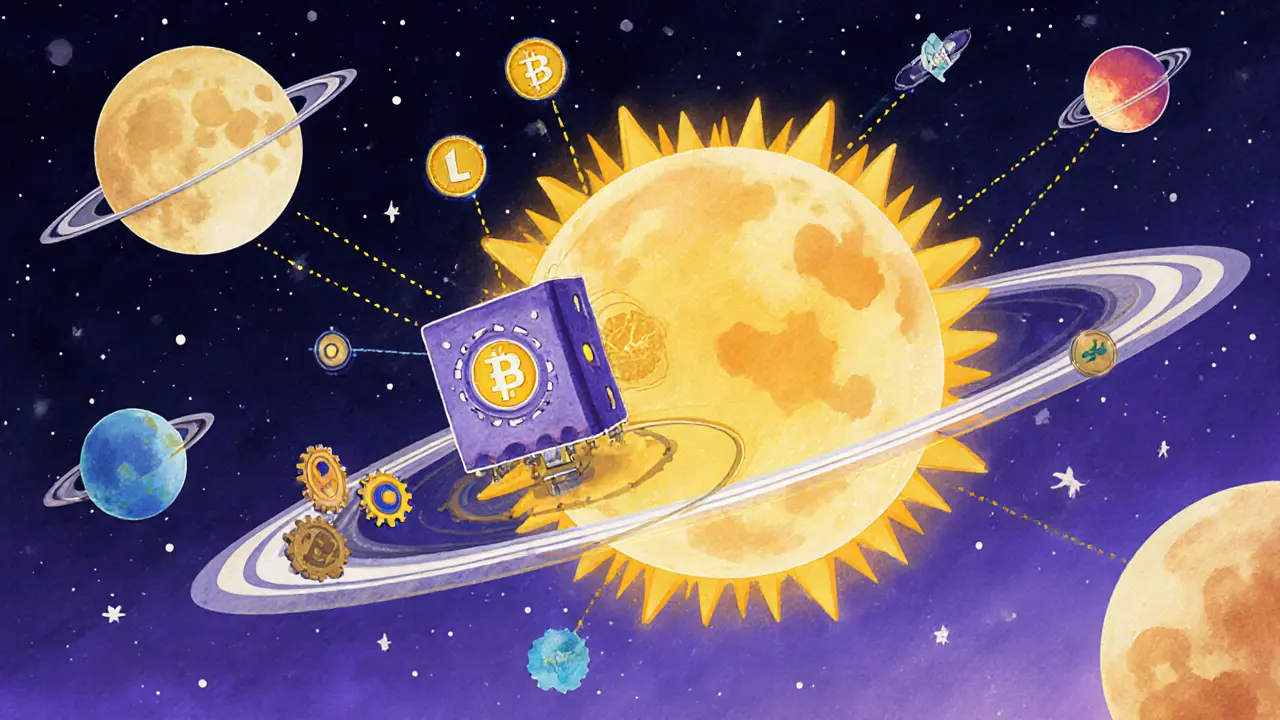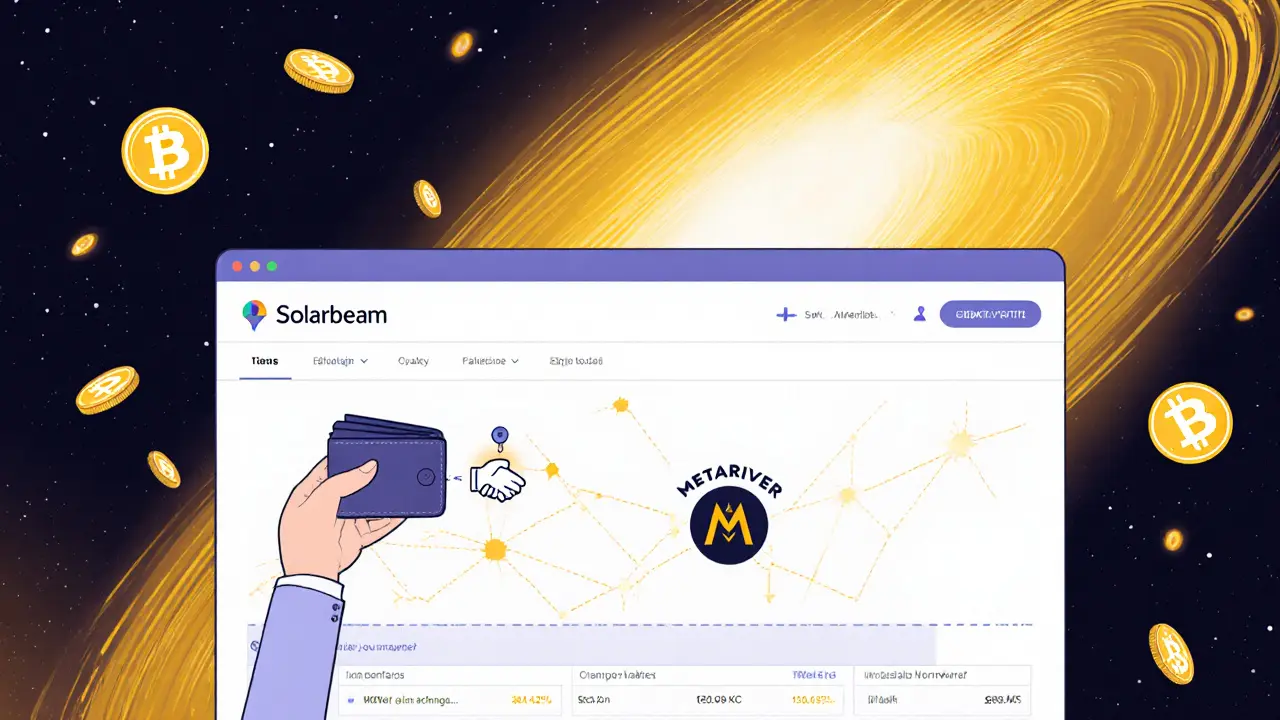Crypto Transaction Fee Calculator
Compare Crypto Transaction Fees
See how much you'll pay to swap tokens across different blockchain networks
Transaction Fee Comparison
When you're looking for a decentralized exchange that’s fast, cheap, and doesn’t require a middleman, Solarbeam keeps popping up. But here’s the thing: it’s not Uniswap. It’s not PancakeSwap. And it’s not even on the same blockchain as most of the big names you’ve heard of. So is Solarbeam just another obscure DEX trying to ride the DeFi wave, or does it actually have something real to offer in 2025?
What Exactly Is Solarbeam?
Solarbeam is a decentralized exchange (DEX) built to make trading between different blockchains smoother. Unlike centralized exchanges like Binance or Coinbase, you don’t deposit your crypto into their wallet. Instead, you connect your own Web3 wallet-like MetaMask or WalletConnect-and trade directly from your account using smart contracts. No KYC, no identity checks, no waiting for withdrawals.
The platform launched in 2021 by an anonymous team, and its name comes from the idea of using the sun’s energy to power blockchain transactions-fast, clean, and endless. But what really sets Solarbeam apart is where it operates. There’s conflicting info out there, but the most current and verified data points to one clear fact: Solarbeam is the leading DEX on the Moonriver Network. Moonriver is a parachain on Kusama, a testbed for Polkadot. It’s not as big as Ethereum or BSC, but it’s growing, and Solarbeam is its go-to trading hub.
It uses an automated market maker (AMM) model, meaning there are no order books. Instead, liquidity pools hold pairs of tokens. When you swap one coin for another, the price adjusts based on how much of each token is in the pool. It’s the same system Uniswap uses, but optimized for Moonriver’s speed and low fees.
The SOLAR Token: Utility and Supply
Every DEX has its own token, and Solarbeam’s is SOLAR. You can’t trade on Solarbeam without it-well, not really. You don’t need SOLAR to swap tokens, but you do need it to earn rewards, vote on governance, and pay reduced trading fees.
The total supply is capped at 44 million SOLAR tokens. As of late 2023, over 43.3 million are already in circulation. That means almost the entire supply is out there. No big token unlocks coming. No inflation surprise. That’s a good sign for long-term holders.
The token’s price hovered around $0.055 in late 2023, according to Coinbase and CoinMarketCap. That puts its market cap around $2.4 million. Compared to Uniswap’s UNI ($1.2B+) or PancakeSwap’s CAKE ($400M+), SOLAR is tiny. But size isn’t everything. If you’re trading assets native to Moonriver-like MOVR, GLMR, or other parachain tokens-SOLAR gives you the best rates and lowest slippage on the network.
Security: A 90/100 Score from CertiK
Security is where Solarbeam shines. In November 2021, blockchain security firm CertiK audited the platform and gave it a score of 90 out of 100. That’s higher than most DEXs in the space. For context, Uniswap V2 scored 87, and SushiSwap scored 82. A score above 85 is considered strong. Solarbeam didn’t just pass-it passed with room to spare.
The audit found no critical vulnerabilities. The platform uses advanced encryption, multi-factor authentication for admin functions, and secure smart contract architecture. It’s not immune to exploits-no DeFi protocol is-but it’s among the safer ones in its niche.
Also worth noting: the SOLAR token contract address is publicly verified on Etherscan and Moonriver block explorers. You can check the code yourself. The address is 0x6bD1...A4334B. If you’re ever unsure whether you’re interacting with the real contract, always verify it against CoinMarketCap or the official Solarbeam site.

How Easy Is It to Use?
Solarbeam’s interface is clean. No clutter. No pop-ups. You connect your wallet, pick a pair, and swap. The design is intuitive-even if you’ve never used a DEX before. There’s no need to understand liquidity mining or yield farming to make a simple trade.
It supports all major Web3 wallets: MetaMask, Phantom, WalletConnect, and others compatible with Moonriver. The platform auto-detects your network and switches to Moonriver if needed. You won’t accidentally send funds to Ethereum or BSC. That’s a big win for beginners.
Transaction fees? Around $0.10 to $0.30 per trade. That’s because Moonriver uses a proof-of-authority consensus, which is far cheaper than Ethereum’s proof-of-work. On Ethereum, swapping tokens can cost $5-$20. On Solarbeam? It’s less than a coffee.
Trading Volume: The Elephant in the Room
Here’s the hard truth: Solarbeam doesn’t move much volume. Coinbase listed 11 active trading pairs for SOLAR in October 2023-but reported $0.00 in daily volume. That doesn’t mean nobody’s trading. It means Coinbase’s data pipeline doesn’t pick up Moonriver-based activity. Other trackers like CoinGecko show sporadic volume, mostly tied to Moonriver-native tokens.
Compare that to Uniswap, which handles $1B+ daily. Solarbeam’s daily volume is likely under $1 million. But here’s the twist: that’s not a flaw-it’s a feature. Solarbeam isn’t trying to be the biggest. It’s trying to be the best on Moonriver. And on that network, it’s #1. If you’re trading Moonbeam or Kusama ecosystem tokens, there’s no better place.

Who Is Solarbeam For?
Solarbeam isn’t for everyone. If you’re trading Bitcoin, Ethereum, or Solana, you’re better off on a bigger DEX. But if you’re into Polkadot, Moonriver, or Kusama ecosystem tokens-then Solarbeam is your home base.
It’s perfect for:
- Users who want low fees and fast swaps on Moonriver
- Investors holding MOVR, GLMR, or other parachain tokens
- DeFi users who value security over hype
- Anyone tired of paying $10 in gas to swap a few tokens
It’s NOT for:
- Traders who need high liquidity for large orders
- People who only trade on Ethereum or BSC
- Those looking for a big-name brand with lots of user reviews
Where to Buy SOLAR Token
You can’t buy SOLAR directly with USD. You’ll need to first get USDT, USDC, or ETH on a centralized exchange like KuCoin, Kraken, or Coinbase. Then, send it to your Web3 wallet and swap it for SOLAR on Solarbeam’s platform.
KuCoin and Kraken list SOLAR as a trading pair, so you can buy it with BTC or ETH. But again-don’t leave it there. Move it to your own wallet if you plan to use it on Solarbeam. Exchanges don’t let you interact with DEXs directly.
Pro tip: Always check the SOLAR token contract address before sending. Scammers love to create fake tokens with similar names. The real one is 0x6bD1...A4334B.
The Bottom Line: Should You Use Solarbeam?
Solarbeam isn’t flashy. It doesn’t have celebrity endorsements or viral Twitter threads. But it’s reliable. It’s secure. And it’s the most efficient way to trade on Moonriver.
If you’re serious about the Polkadot ecosystem or just want a low-cost, no-nonsense DEX with strong security, Solarbeam delivers. It’s not going to make you rich overnight. But if you’re trading Moonriver assets regularly, it’s the smartest tool in your kit.
For everyone else? Stick with Uniswap or PancakeSwap. But if you’re building, holding, or swapping in the Moonriver space? Solarbeam isn’t just an option-it’s the only real choice.
Is Solarbeam a safe crypto exchange?
Yes, Solarbeam is considered safe for a decentralized exchange. It received a 90/100 security score from CertiK in 2021, which is above average for DeFi protocols. Its smart contracts have been audited, and it uses standard security practices like encryption and multi-factor authentication for admin access. However, like all DEXs, you’re responsible for your own wallet security. Never share your private keys or seed phrase.
Can I trade SOLAR on centralized exchanges?
Yes, you can buy and sell SOLAR on centralized exchanges like KuCoin, Kraken, and Coinbase. But if you plan to use it for trading on Solarbeam’s DEX, you’ll need to withdraw it to your Web3 wallet. Centralized exchanges don’t let you interact with decentralized protocols directly.
What blockchain does Solarbeam run on?
Solarbeam operates on the Moonriver Network, a parachain on Kusama that’s designed as a testing ground for Polkadot. While some older sources claim it runs on Binance Smart Chain, verified data from CoinMarketCap and Moonriver block explorers confirm it’s built for Moonriver. This makes it the leading DEX on that network.
How do I connect my wallet to Solarbeam?
Go to the Solarbeam website and click "Connect Wallet." You can use MetaMask, Phantom, or any wallet that supports the Moonriver network. Make sure your wallet is set to the Moonriver chain (RPC: https://rpc.moonriver.moonbeam.network). Once connected, you can start swapping tokens immediately.
Is Solarbeam better than Uniswap?
It depends on what you’re trading. Uniswap is bigger, has more liquidity, and supports more tokens-but it runs on Ethereum, where gas fees are high. Solarbeam is smaller but runs on Moonriver, where trades cost pennies. If you’re trading Moonriver-native assets, Solarbeam is far better. If you’re trading ETH, BTC, or USDT, Uniswap is the clear winner.
What’s the future of Solarbeam?
Solarbeam’s future is tied to Moonriver and Polkadot. If Polkadot’s ecosystem grows, Solarbeam could become a key trading hub for parachain tokens. There’s no public roadmap, but its strong security, low fees, and position as Moonriver’s top DEX give it staying power. The lack of major updates since 2023 is a concern, but the protocol doesn’t need constant changes if it’s working well.
